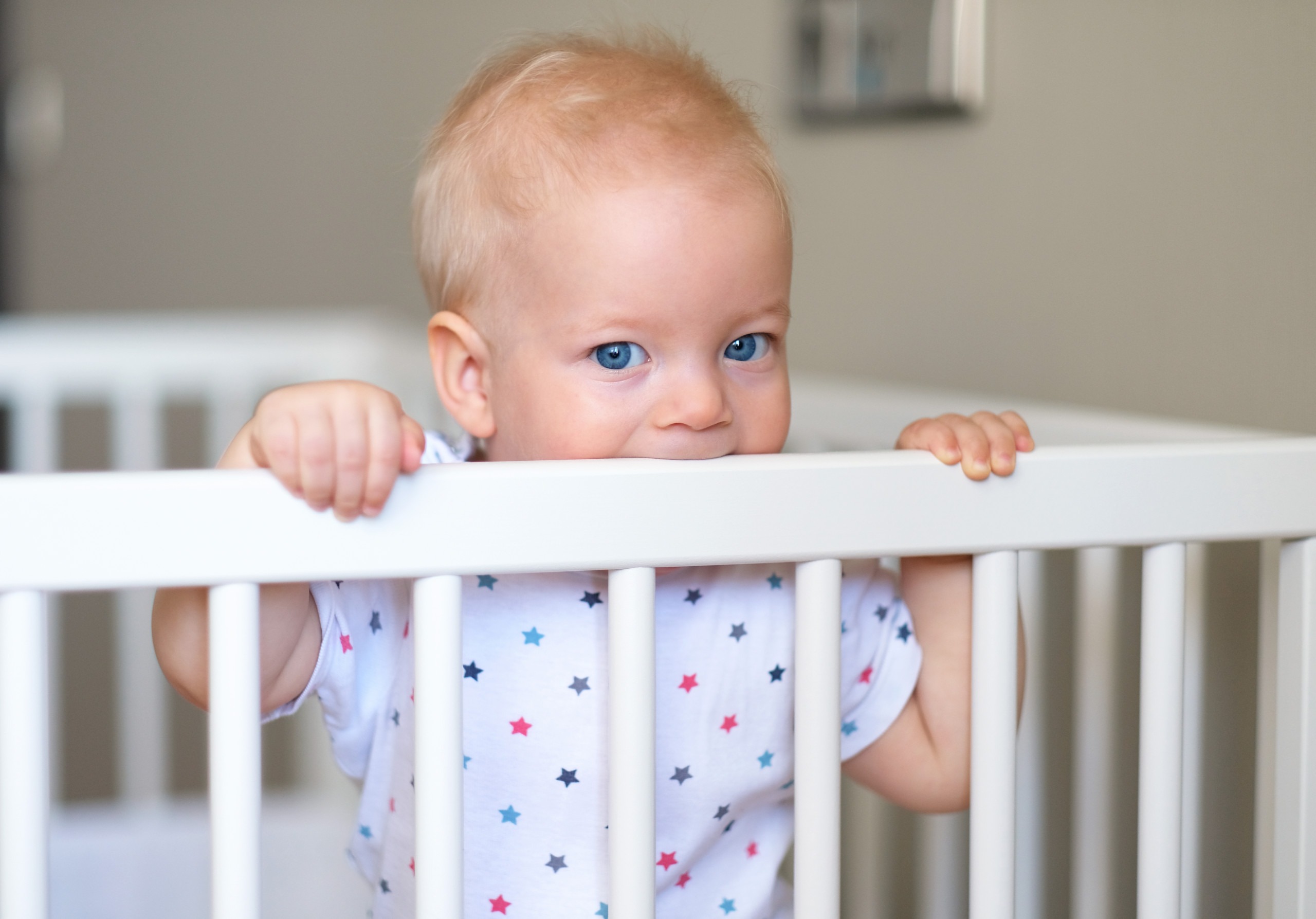Are you wondering how to wean your toddler off bed-sharing (or the “family bed”) and get them sleeping in their own toddler bed all night? If so, you’re in the right place!
I shared my bed with each of my kids for a while. Although there were sweet cuddly times, there was also a lot of kicking, tossing and turning- which led to no sleep! So I know the feeling of being desperate to get your bed (and sleep) back.
This guide walks you through the best age to transition from bed-sharing to a toddler bed. It also explains your options for choosing the right bed for your toddler. And it tells you exactly what to do to get your toddler happily sleeping in their own bed all night long.
This post may contain affiliate links.
At what age should a toddler stop sleeping with their parents?
Many parents wonder what the best age is to transition their toddler out of bed-sharing. The truth is that there is no perfect age.
Transitioning your toddler from bed-sharing to their own bed is a decision to be made by each individual family. Maybe your child is doing 360-degree turns in the bed all night (and kicking you in the ribs to make that happen). Or sharing a bed means your toddler is attached to the breast all night long. Or perhaps when your child is in bed with you, your partner has to sleep elsewhere.
I shared a bed with my daughter when she was a baby (before sleep training) so I know the feeling of waking up exhausted because your Tasmanian Devil kept you up all night.
So, no matter how old (or young) your child is, and no matter your reasons, if you’re ready to get your child sleeping in their own bed, this guide will explain how to do so.
What bed should I transition my toddler to?
Crib, toddler bed, queen bed? Let’s discuss your options.
If your child is younger than 2.5-3 years old:
I highly recommend that they sleep in a crib. That’s because a crib is the safest space for babies and young toddlers to sleep.
The boundaries of a crib keep little ones safe while parents are sleeping and can’t supervise them. Children younger than 3 years old lack the cognitive maturity and impulse control needed to stay in bed. Unless your child has repeatedly climbed out of the crib (and it becomes a safety issue) the crib will get them sleeping best and give you peace of mind.
Want some research to back this up? Check out this study.
Here’s my guide on transitioning from co-sleeping to the crib.
If your child is 3+ years (or is climbing out of the crib):
It’s time to transition them to a big kid bed.
At this age, children are developmentally ready to handle sleeping in a bed without boundaries. They can understand parent’s instructions to not run around the bedroom at bedtime or come wandering out in the middle of the night.
What type of toddler bed should I choose?
Honestly, it doesn’t matter what type of bed your child sleeps in. If your crib converts to a toddler bed, use that! Or if you have a spare single (or bigger) bed, they can sleep there.
My daughter transitioned to a double bed at 3.5 years old because we already had one. She loved having so much room to roll around.
You can install a side rail like this one to keep your child from rolling off the bed.
How long does it take?
With your consistency and a clear plan, this transition should only take a few days. Maybe only one night!
If your child is reluctant to leave the family bed or is nervous about their new bed, it might take a few weeks.
Need some extra help transitioning your toddler out of bed-sharing? My Big Kid Sleep Made Simple program is filled with step-by-step guides and proven advice for getting toddlers happily sleeping in their own beds.
Related: How to stop your toddler from getting out of bed at night
How to get your 2-3 year old sleeping in their own bed
Here are the 7 steps for getting your toddler happily sleeping in their own bed all night.
Step One: Plan it
It’s best if this is the only big transition happening for your little one. If a new sibling is coming soon or you plan to potty train, start daycare or go back to work- make sure to space these transitions apart by four weeks or more.
Step Two: Communicate
You need to hype this up, big time. Start talking about the “wonderful, amazing” news that your toddler will soon be sleeping in their own bed and what a big deal that is. Point out older cousins and friends who get to have their own bedrooms and how your toddler is joining the ‘big kid club.’ Ask their older cousin to call and congratulate them on getting their own bed. (You see where I’m going here, right?)
This should start 1-2 weeks before you plan to transition. Toddlers like to be kept “in the loop.” Springing a new habit (or routine) on them with little notice is bound to lead to tantrums at bedtime (or 2 am) neither of which you want. Let them know what will happen, in advance.
An important distinction- you’re NOT asking for their permission. You are lovingly, yet firmly, letting them know upcoming changes to their routine and sleep space. And always reminding them that you’re nearby checking on them.
Step Three: Set the scene
Their bedroom needs to be transformed into a fun, happy space. You don’t need to spend lots of money to achieve this. Just lots of fun.
Make their room “a big deal” by spending happy time there playing, reading books and snuggling in their new bed. If possible, involve them in picking a bed, sheets or stuffed animals to sleep with. Affordable wall stickers can bring a lot of joy and acceptance to a new sleep space. Do this for at least one week before having your toddler sleep in their new bedroom. HYPE IT UP!
(If your toddler naps independently in your bed, you could begin this transition now by having them nap in their new bed.)
Step Four: Bedtime routine moves to their room
When transitioning out of bed-sharing and into a toddler bed, your bedtime routine should move to your toddler’s bedroom a few nights before they start sleeping there. When the routine is over, they can fall asleep in your bed (if that’s their normal habit.)
The idea here is to subtly introduce a new sleep space without getting huge protests. We’re taking baby steps to help your child adapt to a new sleep space and routine.
Step Five: Camp out for a few nights
Camping out in your toddler’s bedroom for a few nights is a good way to ease the bed-sharing transition, for you both.
One small but important detail is to not share a bed with your toddler. You’re camping out on the floor, which is a separate sleep space. This gets your little one used to a new bed, new room and sleeping on their own. But your presence eases the adjustment for them.
If your toddler is very attached to you, wear their lovey in your shirt a few hours before bed each night. Or use one of your t-shirts as their pillowcase.
Step Six: Wean yourself out of the room
Now it’s time to begin sleep training and wean yourself out of your toddler’s bedroom. This doesn’t have to be as official as it sounds. It’s simply coming up with a clear plan to help your toddler be comfortable falling asleep on their own and sleeping all night in their new bed. If you want detailed guidance and personal support with this, my Big Kid Sleep Made Simple program is your go-to guide. It’s filled with proven and effective advice for getting toddlers to LOVE sleeping in their own beds!
Step Seven: Stay consistent
The only way you’ll get anywhere with the bed-sharing to toddler bed transition is with consistency. Your bed is now “off the menu.” In fact, your bedroom is “off the menu” when it comes to sleep.
All of your child’s sleep now occurs in their bedroom. If your toddler ever has a rough night (due to sickness, sleep regression or another cause) YOU camp out in their bedroom. You want them to forget that your bed was ever an option.
Intermittent reinforcement, or occasionally “giving in,” only confuses your toddler, leading them to continually fight their bed because it sometimes works. Not fair on them or you. So stay consistent!
Continue communicating with your child through each phase. Remind them what you expect of them, inform them of upcoming changes to their routine, and let them know how you will support them. And of course, always remind them how proud you are of them.
To sum up…
The transition from bed-sharing to a toddler bed can certainly feel daunting if your child refuses to sleep without you. But taking the time to make a sleep training plan (and following through with it) will ensure that your little guy or gal is happily sleeping in their own bed all night, in the near future. Need some help making a plan? Book a private consultation here.
















0 Comments